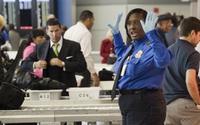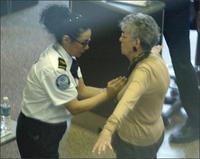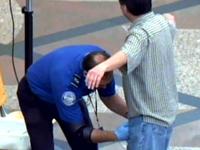-
Privacy pants for airport security
“Privacy pants” would allow airport security personnel to do their job while keeping passengers’ privacy and dignity intact
-
-
TSA to pay special attention to insulated beverage containers
TSA announced terrorists might use insulated beverage containers to conceal explosives, so in the coming days, passengers flying within and to the United States may notice additional security measures related to insulated beverage containers
-
-
Questions about TSA's approach to security technology
The massive push to improve airport security in the United States after the attacks of 9/11 led to a gold rush in technology contracts for an industry that mushroomed almost overnight; since it was founded in 2001, the TSA has spent roughly $14 billion in more than 20,900 transactions with dozens of contractors; in addition to beefing up the fleets of X-ray machines and traditional security systems at airports nationwide, about $8 billion also paid for ambitious new technologies; critics question whether TSA was too eager to look for technological solutions to basic security problem, and willing to write checks for unproven products
-
-
Hope for terahertz: laser operates at higher temperatures than thought possible
Terahertz rays — radiation between microwaves and infrared rays on the electromagnetic spectrum — are a promising means of detecting explosives, but they have proven hard to generate cost effectively. So far, solid-state lasers — the cheap, miniature type of laser found in CD players — have been unable to produce terahertz rays unless they are super-cooled, which makes them impractical for mass deployment; now a group of researchers report a solid-state terahertz laser that operates at nearly twice the temperature that putative proportionality would have predicted
-
-
A woman wearing only black underwear gets hour-long airport security search
An Oklahoma woman tried to avoid being subjected to an enhanced pat-down at the Oklahoma City airport by showing up for the flight wearing only her underwear; the fact that she was wearing black knickers and a black bra did not make a difference, though: after traces of nitrate were found on her body, she was given an enhanced search, which made her miss her flight to Phoenix
-
-
Third lawsuit filed over TSA airport screening

A Colorado attorney has asked a federal judge to order the Transportation Security Administration (TSA) to abandon its airport screening procedures for U.S. citizens; the suit claims that the patdowns the plaintiff, his two daughters, ages 9 and 15, and a family friend were subjected to in San Diego were “disgusting, unconscionable, sexual in nature” and in violation of the Constitution’s protections against unreasonable searches; nationally, at least two other lawsuits have been filed over the TSA’s new procedures; public opinion appears to be shifting against TSA’s “enhanced patdowns,” even as support for full-body scanning appears to remains high
-
-
Versatile terahertz technology could help aircraft to land
Terahertz scanners detect a type of high-frequency electromagnetic radiation emitted by anything with temperatures higher than around 10 kelvin; it can penetrate dry, non-metallic materials such as clothing or sand, but is absorbed by water and metal; terahertz thus makes for very accurate airport scanners — but the technology can also be used to help aircraft land in poor visibility or power high-bandwidth communication systems
-
-
Napolitano says scanners may be used for trains, subways, and boats
DHS secretary Janet Napolitano says that full-body scanners may be deployed in train stations, on subway platforms, and in marinas; experts point out that terrorists would not necessarily need to board a train to do damage: train graffiti is one indication how easy it to access parked trains — and trains roll on miles and miles of exposed track in open landscapes
-
-
Full-body scanner privacy concerns could be easily solved
A U.S. government scientists involved in developing the full-body scanner says privacy concerns can be easily addressed by adding a simple algorithm to the scanners’ computer code; the algorithm distorts the body image into “grotesque” shapes without degrading the scanner’s detection capabilities
-
-
Police radar can identify suicide bombers
The radar guns police use to spot speeding motorists fire microwave pulses at a car and measures the Doppler shift of the reflected signal to calculate its velocity; researchers found that the strength and polarization of the reflected signal — the “radar cross section” — can also measure the reflected signal created by the most common arrangements of looped wiring typically used by suicide bombers
-
-
Tungsten-lined undies protect naughty bits from radiation
A Colorado company offers an attractive line of tungsten-lined undies, aimed, the company says, to protect “the traveling public, airline, medical, and security professionals from radiation generated by security and medical imaging equipment”; business is booming
-
-
Full-body-scan "opt-outs" at U.S airports at normal rate
The organizers of the airport screening “National Opt-Out Day” hoped to exploit the American public’s anger at, and dissatisfaction with, the current state of affairs — anger that found expression earlier this month in the midterm elections — for a spectacular demonstration which would paralyze domestic air-travel during the busy Thanksgiving travel period: they called on travelers to opt-out of full-body scanning, thus forcing TSA screeners to pat them down, bringing air travel to a halt; the organizers failed to reckon with two set of numbers: fewer than 3 percent of travelers receive pat-downs, and the vast majority of Americans — as much as 80 percent — approve of full-body scanners being used at U.S. airports; the result: the stunt has failed, and the number of travelers opting out of full-body scans is not higher than normal
-
-
Lawmakers demand better TSA pat-down training

Lawmakers write the president, TSA to demand a better system of security checks at airports; demand ; “Surely it is possible to secure an airplane without sacrificing individual liberties or privacy. We can utilize bomb-sniffing dogs, AIT machines as a method of secondary screening, and behavioral profiling to accomplish the shared goal of safe and secure air travel,” Rep. Jason Chaffetz (R-Utah) wrote Obama; “These new searches are a novel procedure both for the traveling public and your front line TSA officers, and I am not convinced the Transportation Security officers have received adequate training in what is clearly an invasive procedure,” Senator Olympia Snowe (R-Maine) wrote the TSA administrator
-
-
TSA to make airports screenings "minimally invasive"

The head of the Transportation Security Administration (TSA), facing protests from travelers and pressure from the White House, appeared to give ground Sunday on his position that there would be no change in policies regarding invasive passenger screening procedures; John Pistole said in a statement that the agency would work to make screening methods “as minimally invasive as possible,” although he gave no indication that screening changes were imminent; still, he pointed to the alleged attempt by a Nigerian with explosives in his underwear to try to bring down an Amsterdam-to-Detroit flight last Christmas. “We all wish we lived in a world where security procedures at airports weren’t necessary,” Pistole said, “but that just isn’t the case”
-
-
Q&A: Full-body scanners
Questions are being raised about the privacy and health aspects of wide use of full-body scanners; here is one example: millimeter wave scanners, in theory, ought to be safer than X-rays because millimeter photons do not have enough energy to break chemical bonds; last year, however, researchers at Los Alamos National Laboratory found that while these photons cannot break DNA, they can shake it: this shaking may be so strong that it unzips the two strands in DNA, interfering with the genetic machinery that keeps cells working and healthy
-
- All
- Regional
- Water
- Biometrics
- Borders/Immig
- Business
- Cybersecurity
- Detection
- Disasters
- Government
- Infrastructure
- International
- Public health
- Public Safety
- Communication interoperabillity
- Emergency services
- Emergency medical services
- Fire
- First response
- IEDs
- Law Enforcement
- Law Enforcement Technology
- Military technology
- Nonlethal weapons
- Nuclear weapons
- Personal protection equipment
- Police
- Notification /alert systems
- Situational awareness
- Weapons systems
- Sci-Tech
- Sector Reports
- Surveillance
- Transportation
Advertising & Marketing: advertise@newswirepubs.com
Editorial: editor@newswirepubs.com
General: info@newswirepubs.com
2010-2011 © News Wire Publications, LLC News Wire Publications, LLC
220 Old Country Road | Suite 200 | Mineola | New York | 11501
Permissions and Policies
Editorial: editor@newswirepubs.com
General: info@newswirepubs.com
2010-2011 © News Wire Publications, LLC News Wire Publications, LLC
220 Old Country Road | Suite 200 | Mineola | New York | 11501
Permissions and Policies
